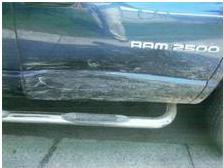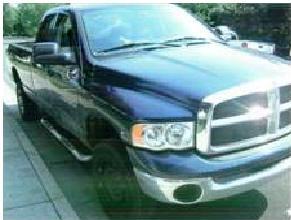In my last post, I laid out the events leading up to the trial. The trial concerning the motor vehicle accident in Medford came before the Honorable Judge Ron Grensky in October, 2012.
The Defense Attorney was Jose Cienfuegos, in-house counsel for Allstate. He did an excellent job, and was easy to work with. He is also a good friend of mine, but we didn’t let that get in the way of advocating strongly for our respective clients. I am convinced that he will make a great plaintiff lawyer someday.
In the course of arguing this case, several issues arose that impacted the ultimate outcome:
1. Low speed impact. Here is what my property damage looked like:
2. Prior degenerative conditions. My client had several, in both his neck and right shoulder. The friendly Independent Medical Examiner (IME) was crucial in this issue, as the jury was obviously skeptical even with his beneficial testimony. Defense counsel caught this and really did a good job in playing on that skepticism.
3. Impaired Earning Capacity is difficult to quantify. Two vocational experts testified my client could still work, just in a different capacity. He was not earning much at the time of the collision (or any year leading up to it), and could actually earn more working a full time, minimum wage job. Because I could not apply an exact mathematical calculation for the claim, Judge Grensky nearly struck it sua sponte. However, I was prepared with the proper briefing and was able to keep the claim in the case.
4. Noneconomic damages. Although my client could no longer bow hunt or salmon fish, he was rifle hunting and trout fishing by the time of the trial. Although these are significantly different activities in my client’s eyes and lifestyle, the jury didn’t seem to fully appreciate the difference.
5. Mitigation of damages. My client refused to look seriously for a different line of work and testified that he had applied for “a couple” of jobs since the collision four years prior. Also, when he was asked why, he responded, “Because I was waiting for this case to wrap up.” Defense counsel had a heyday with that and quite aptly made my client look like he was just waiting for his boat to come in, fishing and hunting in the meantime. I am convinced that statement alone cost my client $100,000+.
6. Prior symptoms. My client had a long history of low back pain radiating down his legs with work activity as well as hunting activity. He had treated for one episode of neck pain within a year of the collision in issue. Defense counsel used this to argue that his body was telling him that it was time to quit working and playing so hard. This argument seemed to resonate with several jurors.
7. Dead defendant. The defendant, who was 92 at the time of the collision, had since passed away. His wife, appointed as the Personal Representative of the Estate, was not healthy enough to attend the trial. I was able to reject several potential jurors for cause when this fact was brought up in jury selection, though it was obvious that it was more than just a passing concern with most jurors.
8. At one point, the Defense counsel blurted out how “important this case is to his clients,” alluding to the issue that the defendant was dead and his wife also elderly and ill. This made the jury concerned about the effect of the case on the Estate. Based on the likelihood of this statement clouding the outcome of the jury’s deliberations, I really wanted to ask for a mistrial, but my client literally could not make ends meet long enough for a retrial.
An excellent lineup of experts testified for both the Plaintiff and for the Defense.
For our client, we called the following experts:
1. Dr. Tom Carlsen, a retired orthopedic surgeon of Bend, OR. Dr. Carlsen testified for us based on a records review only. Dr. Carlsen testified that my client’s injuries were permanent, not likely to improve on their own, and will necessitate further treatment, to the tune of “at least $1,000 per year for the next 30 years.” (My client is 49 years old, and life expectancy tables give him an additional 30 years.)
2. Robert Kelty, D.C. of Central Point, OR. Dr. Kelty did a really good job explaining the neck and mechanism of injury. He only treated my client for two months, but had seen him in the years prior for low back pain. He did well, considering his minimal treatment post injury.
3. Karen Walz, PT of Redmond, OR testified via videoconference. I used Ms. Walz to testify about the testing and results of the Work Capacity Evaluation she performed earlier this year. She did quite well.
4. Eileen Fredrickson, vocational expert, of Bend, OR. She testified on the difficulties my client would have trying to change occupations and showed why he is virtually unemployable given his physical limitations, lack of experience, lack of education, and lack of training.
The Defense called the following experts:
5. Dr. Douglas Morrison, the Independent Medical Examiner (IME). As I mentioned above, the IME’s report was crucial to our case, as it established that his medical treatment was related to the accident at issue and not prior degenerative conditions. He tried to stray at trial, but I continually called him back to the facts of his report. I scanned it, highlighted it electronically, and projected his opinions on the screen behind him as I kept him on task. It was an extremely effective method.
6. Scott Stipe, vocational expert. I had him admit, repeatedly, that the “universe of jobs Plaintiff was able to work has been significantly shrunk due to his injuries.” He also admitted that an injured person “might” have more difficulty changing lines of work, particularly when that person had no work history in that line of work and was competing against younger applicants. Mr. Stipe was such an excellent expert witness, I would use him in the future in my own cases.
I mentioned projecting the IME’s report on the screen behind him and using electronic highlighting tools to emphasize the facts in his report. I used other technology tools to bolster my case, as well. I also used my iPad throughout trial. It was well received by the jury. I also played the perpetuation depositions of my doctor and chiropractor through my laptop and a projector. The projection of the testimony on a huge screen, rather than on the court’s tiny TVs, seemed to emphasize my experts. I think the use of such technology is really expected these days, regardless of venue.
My next, and final, post on this case will detail the trial results.
Lawyer Timothy Williams | Top Attorney Personal Injury | Tim Williams Attorney Profile



